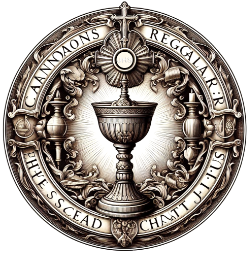Marian Devotion and the Saints: A Communion of Love and Intercession
In the great symphony of Catholic spirituality, few melodies are as enduring and tender as the Church’s devotion to the Blessed Virgin Mary. Yet this devotion is not a solitary note—it is harmonized by the voices of the saints, who throughout the centuries have turned to Mary as Mother, Advocate, and Queen. Marian devotion and the saints are inseparable realities: the saints teach us how to love Mary rightly, and Mary, in turn, leads us more deeply into the heart of Christ. Together, they form a luminous constellation in the Church’s sky, guiding the faithful on the path of holiness.
I. Theological Foundations: Mary and the Communion of Saints
Catholic theology affirms that Mary holds a unique place in salvation history. As the Mother of God (Theotokos), she is the first and most perfect disciple, the one who gave her fiat to the Incarnation and stood faithfully at the foot of the Cross. Her role is not competitive with Christ’s, but entirely dependent on and oriented toward Him. As the Catechism teaches, “Mary’s function as mother of men in no way obscures or diminishes this unique mediation of Christ, but rather shows its power” (CCC 970).
The saints, for their part, are those who have responded heroically to grace and now dwell in the glory of heaven. They are not distant figures but active members of the communion of saints, interceding for the Church on earth. Marian devotion is deeply embedded in this communion: the saints venerate Mary not as a goddess, but as the most exalted member of the Church, the Mother of all the living, and the surest guide to her Son.
II. Saints Formed by Mary: Witnesses Through the Ages
From the earliest centuries, the saints have turned to Mary with filial love and theological clarity. Their writings, prayers, and lives form a treasury of Marian devotion that continues to inspire the faithful.
St. Irenaeus of Lyons (2nd century) called Mary the “New Eve,” whose obedience untied the knot of Eve’s disobedience.
St. Bernard of Clairvaux (12th century), known as the “Marian Doctor,” composed the Memorare and taught that Mary is the “aqueduct” through which grace flows.
St. Louis de Montfort (17th century) developed the spirituality of Total Consecration to Jesus through Mary, calling her the “surest, easiest, shortest, and most perfect means” to union with Christ.
St. Maximilian Kolbe (20th century), martyr of Auschwitz, founded the Militia Immaculatae and declared, “Never be afraid of loving the Blessed Virgin too much. You can never love her more than Jesus did.”
These saints did not worship Mary—they loved her as their spiritual mother, trusted her intercession, and imitated her virtues. Their Marian devotion was not sentimentalism but a profound theological and mystical reality.
III. Marian Apparitions and the Saints
Throughout history, Mary has appeared to humble souls, often saints, to call the Church to prayer, penance, and deeper love for her Son. These apparitions, while private revelations, have borne immense spiritual fruit.
St. Juan Diego received the apparition of Our Lady of Guadalupe in 1531, leading to the conversion of millions in the Americas.
St. Bernadette Soubirous was entrusted with the message of Lourdes in 1858, where Mary identified herself as the Immaculate Conception.
Sts. Francisco and Jacinta Marto, along with Servant of God Lucia dos Santos, were the young visionaries of Fatima in 1917, where Mary called for the Rosary, reparation, and consecration to her Immaculate Heart.
These saints remind us that Marian devotion is not a private piety but a prophetic voice in the life of the Church, calling us to conversion and communion.
IV. The Rosary: A School of Saints
The Rosary, long cherished by the saints, is more than a repetitive prayer—it is a contemplative journey through the mysteries of Christ, seen through the eyes of Mary. Saints across the centuries have testified to its power:
St. Dominic promoted the Rosary as a weapon against heresy and a path to contemplation.
St. Pio of Pietrelcina called it “the weapon for these times.”
St. John Paul II described it as “a compendium of the Gospel” and added the Luminous Mysteries to deepen its Christocentric focus.
The Rosary forms saints because it forms hearts—hearts that ponder, like Mary’s, the mysteries of salvation and are conformed to Christ.
V. Marian Devotion and the Path to Holiness
The saints show us that Marian devotion is not an end in itself but a means to holiness. Mary is the mirror of the Church, the model of discipleship, and the mother who nurtures Christ in us. Her virtues—humility, purity, obedience, compassion—are the virtues of every saint.
To love Mary is to:
Trust in God’s providence, as she did at the Annunciation.
Stand firm in suffering, as she did at Calvary.
Rejoice in God’s mercy, as she did in the Magnificat.
Serve others, as she did at Cana and in the Visitation.
The saints did not merely admire Mary—they imitated her. And in doing so, they became radiant icons of Christ.
Conclusion: A Family of Saints, A Mother for All
Marian devotion and the saints are not two separate devotions—they are one movement of grace. The saints teach us how to love Mary, and Mary teaches us how to become saints. In her, the Church sees her destiny; in the saints, we see her fruitfulness.
To walk with Mary is to walk with the saints. To pray with the saints is to join Mary in her eternal Magnificat. And to love them both is to love Christ, who gave us His Mother and calls us to be holy as He is holy.
As St. Thérèse of Lisieux once said, “She is more Mother than Queen.” And in her maternal embrace, the saints have found their strength, their joy, and their home.
Sanctuary of Fatima, Portugal, 12th May 2025: Candle Procession on the Anniversary of the First Apparition of Mary in 1917.


